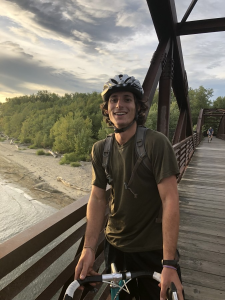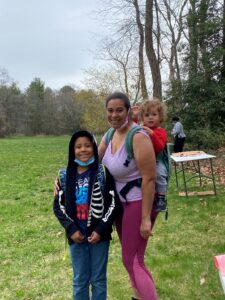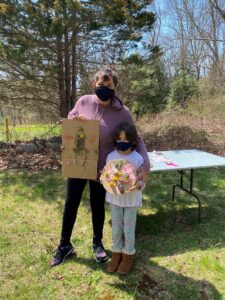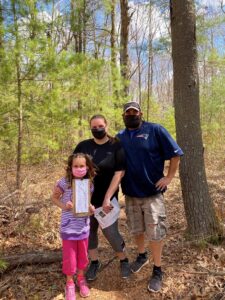The Next Environmental Movement: YOU!
By, Evan Foster 2020-2021 TerraCorps Member

Have you ever asked yourself: what can I do to help the environment? Me too.
The idea for designating one day for the celebration of Earth stems back to the 1970’s when the environmental movement was just coming into focus. The book by Rachel Carson called Silent Spring slingshot the environmental movement forward. Earth Day was a product of this excitement as conservationists saw an opportunity to raise awareness about the problems facing our planet. From soil degradation to pesticide spraying to habitat loss, the necessary conversation was beginning to happen. But then, something unexpected happened. Very little sustained change occurred. The awareness was there, the science was available and the desire from experts for change was strong. So, what was missing? In an attempt to explain this, I will simply tell my story and the story of Earth Week with the Attleboro Land Trust (ALT).
What Can I Do to Address Land Inequity?
My service term with the ALT began back in January when I decided to gain experience with a local land trust to better understand their work. I stepped into the role of Community Engagement and Land Stewardship Coordinator. With this role came many responsibilities including clearing trails, removing invasive species, creating trail maps, engaging the public, and hosting community events. I quickly began to realize that my responsibilities were much more than just the title. The same sentiment between land trust members continued to come up: how do we engage with a younger and more diverse audience? This is a common problem that many land trusts share throughout this area. Currently, land trusts are dominated by older, white community members that have been associated with the land trust for many years. There is no simple explanation as to why this has occurred, but it is a clear obstacle against the long-term sustainability of land trusts that heavily rely on their community to succeed.
Currently, land trusts are dominated by older, white community members that have been associated with the land trust for many years. There is no simple explanation as to why this has occurred, but it is a clear obstacle against the long-term sustainability of land trusts that heavily rely on their community to succeed.
I wondered to myself, what can I do? It can be an intimidating question to ask yourself but a necessary one. I thought of my education and TerraCorps training where I learned about how underserved communities have been disproportionately deprived of land access. When we think of land access, we also have to think about the many beneficial health effects that land access has on communities ranging from healthy food to clean water to recreation areas. Access to open space is vital to a healthy community, and every community deserves the right to experience this. Earth Day was an opportunity to engage with those communities that have previously been absent in the ALT’s work; an opportunity for education, growth, and inclusion for everyone.
Growing Connections to Land
 The week started with a nature scavenger hunt that occurred on the Nickerson Walking Woods Preserve where families meandered through fields, swamps, and forests in search of nature. Having advertised these events through many different outlets including the Attleboro Be Heard Coalition, many local families attended the events. The Attleboro Be Heard Coalition aims to increase equity in the Attleboro public schools through conversations and action. My hope for the ALT Earth Week events was to provide an opportunity for families new to the properties a chance to explore and discover them. This was evident as the eyes of the kids glanced from a pine tree swaying in the wind to a wild turkey running in the opposite direction to an insect flying by their head. Their excitement carried them from the start to end, sometimes getting in the way of finding the objects on the list, but never stopping them from noticing the things around them. When I caught up with the families in the middle of the trail, the questions spilled from the kids’ mouths. They asked about the trees, wetlands, plants, flowers, clouds, turkeys, squirrels, and so much more. I answered each one as quickly as I could as the next question was already coming at me. I wondered to myself: would they have ever asked these questions if they had not come to this event?
The week started with a nature scavenger hunt that occurred on the Nickerson Walking Woods Preserve where families meandered through fields, swamps, and forests in search of nature. Having advertised these events through many different outlets including the Attleboro Be Heard Coalition, many local families attended the events. The Attleboro Be Heard Coalition aims to increase equity in the Attleboro public schools through conversations and action. My hope for the ALT Earth Week events was to provide an opportunity for families new to the properties a chance to explore and discover them. This was evident as the eyes of the kids glanced from a pine tree swaying in the wind to a wild turkey running in the opposite direction to an insect flying by their head. Their excitement carried them from the start to end, sometimes getting in the way of finding the objects on the list, but never stopping them from noticing the things around them. When I caught up with the families in the middle of the trail, the questions spilled from the kids’ mouths. They asked about the trees, wetlands, plants, flowers, clouds, turkeys, squirrels, and so much more. I answered each one as quickly as I could as the next question was already coming at me. I wondered to myself: would they have ever asked these questions if they had not come to this event?
Facilitating Explorations
The second day took us to the 4-acre Larson Woodland property which sits on the edge of the Ten Mile River where the moving water captivates anyone who walks by. A beautiful day presented itself to us as the sun streamed through the few wisps of clouds that were in the sky. With two energetic volunteers with biology backgrounds, we were ready for the Exploration and Gather Event designed to encourage kids to explore the property in search of unique items. A 12-person group of closely related families exploded out of their cars with energy that bounced from one person to the other. The families were led by Danielle Cournoyer who is the coordinator for Attleboro Community Garden which works closely with the land trust. Egg cartons equipped with clues as to where to find unique items were handed out, and the kids were off. If you have ever seen a group of kids let loose for an Easter egg hunt then you know what this sight looked like. However, there was a distinct difference during this event. Instead of searching for plastic eggs, these kids were discovering bird eggs, acorns, rocks, lichen, flowers, mosses, and leaves. I wondered to myself: would they have ever noticed these things if they had not come to this event?
Engaging through Art

Our third event carried us over to the Deborah and Roger Richardson Nature Preserve for the Nature Art Event where kids gathered natural items to create art with. The wind was strong but the families’ determination was even stronger. The families started the event by walking the mile-long loop through captivating wetlands that contained fairy houses scattered throughout. As the bags were filled with natural items, the imagination for their art was growing. The kids came running to the tables equipped with their materials and eager to start creating nature art. Creativity flowed from their brains to their hands as the assembly began. Deserted islands, stick-humans, nature collages, and various birds were all products of this creativity. I wondered to myself: would they have ever picked up that oak leaf if that had not come to this event?
Building Awareness
Earth Day! The fourth day of Earth Week took us back to the Nickerson Walking Woods Preserve where we held the second rendition of the Nature Scavenger Hunt. An updated list consisted of even harder items to find that required a heightened sense of awareness. The families were equipped with their lists and set off in search of snakes, frogs, and butterflies. A successful event looked something like this: smiling kids jumping from one rock to another while shouting out different trees, plants and insects that they were seeing. I wondered to myself: would they have ever jumped from rock to rock in the middle of a forest if they had not come to this event?
Observing Diversity in Nature
 The final day brought us back to the Deborah and Roger Richardson Nature Preserve for the Plant and Tree Identification Event where numbered signs marked different types of plants and trees throughout the property. The challenge with identifying trees with no leaves cannot be overstated, but these families were determined to learn! They set out with their guide in hand and began the quest to learn about the living things around them. Each station offered a chance for observations about the shape of the leaves, the height of the plant, the type of bark and the color of the flowers. Each station offered knowledge that was tucked away in their brains. By the end of the event, the kids were the experts in identifying the plants and trees. Some were already moving on to species that were not on the list! I wondered to myself: would they have ever learned about these plants and trees if they had not come to this event?
The final day brought us back to the Deborah and Roger Richardson Nature Preserve for the Plant and Tree Identification Event where numbered signs marked different types of plants and trees throughout the property. The challenge with identifying trees with no leaves cannot be overstated, but these families were determined to learn! They set out with their guide in hand and began the quest to learn about the living things around them. Each station offered a chance for observations about the shape of the leaves, the height of the plant, the type of bark and the color of the flowers. Each station offered knowledge that was tucked away in their brains. By the end of the event, the kids were the experts in identifying the plants and trees. Some were already moving on to species that were not on the list! I wondered to myself: would they have ever learned about these plants and trees if they had not come to this event?
Showing up for the Work
So I ask again, have you ever asked yourself: what can I do to help the environment? Me too. There are things that we can do! In order for us to sustain the success of land conservation, our communities need to be invested in the work. This work includes both land equity and conservation as they are inherently tied together. As we continue to understand the benefits of preserving land, we also need to continue working to make land access a universal right for all communities. The environmental movement will only succeed when the common public engages and deeply cares about the natural world and land equity. It will not be scientists, governments or corporations that save our planet. It will be YOU!
Evan is serving his first year at the Attleboro Land Trust as both a Community Engagement Coordinator and a Land Stewardship Coordinator. He recently graduated from the University of Vermont with a degree in Environmental Science and a minor in Geospatial Technologies His passion for environmental work stems from his time working at a canoe camp in Northern Ontario along with his semester abroad program in Mongolia that focused on conservation work. Along with his passion for environmental work, he is an outdoor enthusiast because of his interest in skiing, rock climbing, biking, canoeing, hiking and running. Evan is hoping to use his past experiences and education to excel at his new position while learning how to connect with his community about their local land.
TerraCorps is an environmental nonprofit growing a more equitable ecosystem of people and organizations to protect and steward land for broader good. Visit our website to learn more about serving as a Member or becoming a Service Site Partner organization
